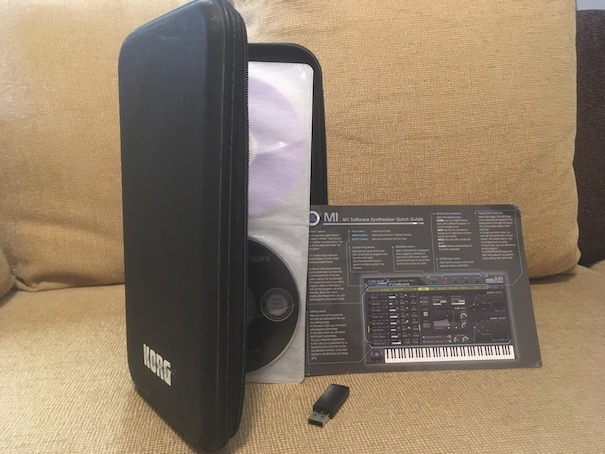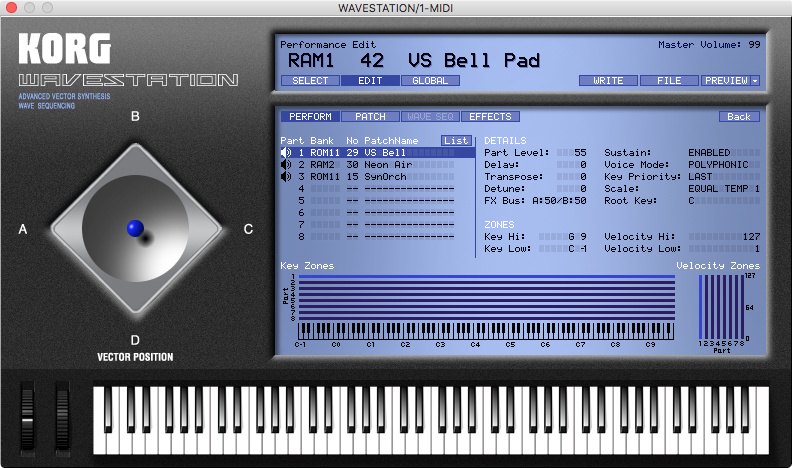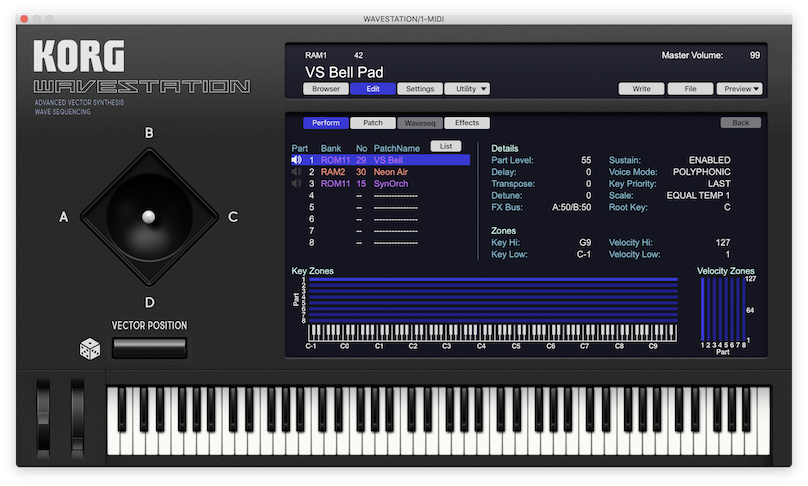Maybe You Don't Need a Hardware Wavestation After All
Sadly, I've never owned an original hardware KORG Wavestation. When they were new in the early 1990s, they were prohibitively expensive to me. My records show that I've purchased the KORG Legacy Collection Digital Edition from Musikhaus Thomann in May 2006. It included VST and AU versions of M1 and Wavestation, with the MDE-X effects added for good measure. (I still have the massive CD case wallet that was included in the package! It has been very useful.)

There was also a separate Analog Edition with VST/AU versions of PolySix, MS-20, and the Legacy Cell to combine sounds from the different synths. Later KORG also added a version of the Mono/Poly to the Legacy Collection. They have been providing upgrades at very reasonable prices over the years, often slightly favoring existing customers.

Some time after that KORG combined the Analog and Digital Editions into one KORG Legacy Collection. Ever since then there has been a steady stream of updates, with 64-bit compatibility arriving as early as 2013. Sometimes there has been a longer time between updates, but in 15 years it has become obvious to me that KORG really are in this for the long haul. That's why it's both funny and sad at the same time to read some self-appointed experts declare that KORG has "abandoned" the software and "doesn't care" for their customers. Well, as they say on the Internet, "you won't believe what happened next".
The KORG Collection 2 update; the new wavestate
Earlier this year (2020) KORG updated the Collection to version 2 as a free upgrade to existing users. The biggest new feature was all new resizable user interfaces for all the included synths. It was getting increasingly difficult to use them with new high-resolution retina screens, so this was definitely a long overdue update. Did I mention that the update was free? Of course, KORG runs sales at least twice a year, so you almost always have a good chance of getting any of the KORG Collection synths for a true bargain price.

On the feature side there is actually not that much to add anymore: it's all been done over the years. Of course, you can always bring new synths into the fold, like the KORG Triton just at the end of 2019.
Since this is specifically about the KORG Wavestation, it's good to point out that over the years the virtual software version of the Wavestation has seen just as much love as the other synths in the collection. It has evolved into a truly complete version of the Wavestation, with features that far surpass the original hardware versions.
The release of the KORG wavestate early this year has seen old hardware Wavestations surge in value on eBay and Reverb. Even though I have both the KORG Collection version and the new Wavestate hardware synth, I've still been looking for a hardware Wavestation, specifically the A/D model, which is the only version that has an audio input. That still isn't featured in the virtual instrument version.
Plug-in, the king of convenience
What does the virtual instrument version of the Wavestation have that the hardware doesn't? It all boils down to convenience, completeness, and ease of use.
The KORG Collection version of the Wavestation has all the waveforms and all the sounds of all the hardware versions. Yes, all of them. Additionally, it has new sounds that take advantage of the resonant filter that KORG added in version 1.6. Amazingly, the original hardware Wavestations did not have filter resonance, and that is something you really need if you want to make convincing emulations of analog synth sounds. Of course, if you don't, you might not even care, but that is definitely a big improvement over the hardware.
The desktop version also can import System Exclusive files created for the original hardware versions. There are a lot of sounds out there for the Wavestation, both free and paid. What with the 1,500 factory presets and all those third-party banks, you will not run out of sounds any time soon.
Of course, you can always make your own sounds, and you could argue it's what any synth is intended for, anyway. That is a lot easier on the desktop than on the original hardware, because on the original, EX, and A/D models you would have to do a lot of menu diving, and on the SR the screen is so small that you might get frustrated and start looking for a good computer editor. Or, if you run out of ideas, you can always use the new random button! (Not found on any hardware version, as far as I know.)
In KORG Collection 2, the Wavestation also has abandoned the LCD emulation screens, although I found them kind of cute, even if they did not actually contribute positively to ease of use. Now the new resizable user interface is paired with a more desktop-traditional set of components, which are just fine, and very easy to use.
Unfortunately the documentation for the Wavestation plug-in has not been updated since version 1.1. I would definitely like to see all the new features documented in a fresh user manual for the KORG Collection 2 version. Of course, this is an opportunity to write a companion book. (Let me know if you would be interested in that.)
How does the software version of the Wavestation sound against the hardware? (I keep distinguishing between software and hardware like that, even though we all know that the hardware versions are really just software on custom hardware.) Well, in 2017 Woody did a comparison, and if this is a topic that you care about, you should watch that and make up your own mind, and maybe even read some of the comments (daring, I know--proceed at our own risk).
I don't think the difference is meaningful, to be honest. I would call it "close enough".
But me want hardware
So what all this boils down to is I see no real reason to get a hardware Wavestation over the (often bargain-priced) desktop version, unless you either need a 61-key keyboard (original Wavestation, Wavestation EX) or an audio input to process sounds (Wavestation A/D). If you just need a preset machine, and can get the Wavestation SR for a price that is not insane, then why not.
I completely understand if you simply want a hardware Wavestation, full stop. I certainly still think I do, but I'm sort of trying to rationalize myself out of it, so that I could just focus on getting the most out of the desktop version. And I haven't even mentioned the iPad version, the iWAVESTATION, which is also comparable to the hardware versions.
Some months ago I got the new KORG wavestate, and I'm trying to learn it well enough to make original sounds. Somehow I feel I can't really proceed with that unless I understand the original Wavestation and its wave sequencing better. It may be better to use the plug-in for that instead of messing around with a hardware version, but if there is a bargain opportunity, I'm not going to pass it. Caveat emptor, or something.
 digitalsynth.net
digitalsynth.net